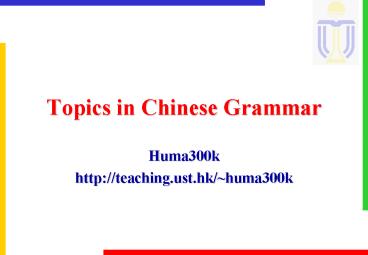Topics in Chinese Grammar - PowerPoint PPT Presentation
1 / 14
Title:
Topics in Chinese Grammar
Description:
Topics in Chinese Grammar Huma300k http://teaching.ust.hk/~huma300k 1. Introduction 1.1 A Cognition-based Functional Approach Target: The grammar of Chinese ... – PowerPoint PPT presentation
Number of Views:264
Avg rating:3.0/5.0
Title: Topics in Chinese Grammar
1
Topics in Chinese Grammar
- Huma300k
- http//teaching.ust.hk/huma300k
2
1. Introduction
- 1.1 A Cognition-based Functional Approach
- Target The grammar of Chinese (including
Mandarin and Cantonese) - Not a comprehensive survey of Chinese grammar
- Course description --
- A study of selective topics in Chinese grammar,
with emphasis on understanding the structural
principles of Chinese in terms of basic human
cognitive abilities and conventional imageries in
conjunction with general principles of
communication.
3
1. Introduction
- A study of Chinese grammar in a cognition-based
functional approach - Functional
- The fundamental function of language is to
communicate ideas. - Linguistic structure should be explained
primarily in terms of linguistic function. - Cognition-based
- look at grammar from the perspective of
expressing ideas and thoughts.
4
1. Introduction
- language is part of a cognitive system which
comprises perception, emotions, categorization,
abstraction processes, and reasoning. - All these cognitive abilities interact with
language, and are influenced by language. - The study of the way we conceive, express and
exchange ideas and thoughts. - 1.2 A Cross-linguistic Comparative Approach
- Differences and similarities
- beyond mere descriptions
- explanations of the differences and similarities
5
1. Introduction
- 1.3 Sample Questions
- 1.3.1 Differences (Language Particulars)
- 1 Making mistakes
- Situation A girl has married a man. The marriage
is a mistake. - (1) ??????S(ubject) V(erb)-wrong O(bject)
- (2) She has married the wrong guy. S(ubject)
V(erb) wrong-O(bject) - expressing ideas and thoughts
- two different conceptual systems
6
1. Introduction
- Chinese the mistake -- the action which the
subject performs - English a discrepancy between the person she set
out to marry and the person she has actually
married. - 2 The word order of yesterday
- Situation Somebody did something yesterday.
- (3) ?????????
- (4) ?????????
- (5) ?????????
- (6) Yesterday he bought a book.
- (7) He bought a book yesterday.
7
1. Introduction
- The order of temporal words ???????today, Friday
- Why? Explain the difference.
- 1.3.2. Commonalities (Language Universals)
- Language variation seems to be unlimited.
- Languages could differ from each other without
limit, and in unpredictable ways. (Martin Joos
1957) - 3 Relative order of Subject, Verb, and Object
- (8) ??????(Subject (S) Verb (V) Object (O))
- (9) John hit Smith. (SVO)
- SVO langs Chinese, English, French, Igbo,
Vietnamese,
8
1. Introduction
- (10) (Japanese) Taroo ga ringo o tabeta.
Taroo-apple-ate (SOV) - SOV langs Japanese, Navajo, Basque, Turkish,
ASL, German and Old English (to certain extent)
- (11) (Scottish) Chunnaic an gille an cu dubh.
saw-the-boy-the-dog-black (VSO) - VSO langs Tagolog, Bulgarian, Arabic, Welsh,
Scottish, - Possible combinations SVO, SOV, VSO, VOS, OSV,
OVS - Actual combinations
9
1. Introduction
- Syntactic universal Preference for word order
types - SVO lt SOV lt VSO lt VOS lt OVS
- (13) (11) (6) (2) (1)
- (The numbers give the frequencies of the word
order types in 30 languages.) - Greenberg (1966)
- How to explain?
- The subject precedes the object.
- There is a conceptual priority in the energy flow
from an Agent to a Patient. - reflected in the great majority of preferred word
orders in the worlds languages
10
- 4 Word order in a complex noun phrase
- The relative word order of D (demonstrative,
determiner), Q (numeral), A (adjective) and N
(head noun) in a noun phrase - D-Q-A-N
- The ten pretty balloons (English)
- ???????? (Chinese)
- D-Q-N-A (French, Italian, etc.)
- Q-N-A-D (Vietnamese, Indonesian, etc.)
- Possible combinations
- P4 4.3.2.1 24
- D-Q-A-N D-Q-N-A D-A-Q-N D-N-A-Q D-N-Q-A
Q-A-N-D Q-A-D-N
11
- 6 actual combinations
- (1) D-Q-A-N (German, English, Chinese, Finnish,
Hindi, Hungarian, etc.) - (2) N-A-Q-D (Diegueno, Swahili, Kikuyu, etc.)
- (3) N-D-Q-A (Kikuyu less popular variant, etc.)
- (4) D-Q-N-A (French, Italian, etc.)
- (5) D-N-A-Q (Kabardian, Warao, etc.)
- (6) Q-N-A-D (Basque, Indonesian, Vietnamese,
Welsh, etc.) - (a) DQAN(? ?? ??? ??)
- (b) DQNA(? ?? ?? ???)
- (c) DNAQ(? ?? ??? ??)
- (d) QNAD(?? ?? ??? ?)
- (e) NAQD(?? ??? ?? ?)
12
- When any or all of the items (demonstrative,
numeral, and descriptive adjective) precede the
noun, they are always found in that order. If
they follow, the order is either the same or its
exact opposite. (J. Greenbergs 1963, 1966
Universal) - (1) (2) (3)
- Chinese English German (updated May 02)
- Chinese (1) ?? (2)?? (3)??? (4)? (5)? ?
- English (1) the (2) ten (3) pretty (4) red (5)
wooden balls of (1) mine - German (1) meine (2) zehn (3) schonen (4) roten
(5) holzernen Kugeln - Chinese (1)?? (2)? (3)?? (4)??? (5)?? (6)???? ?
(7)??? (8)??? (9)? (10)? ?? - English (1) all (2) the (3) ten (4) pretty (5)
young (6) American children's (7) twenty (8)
little (9) old (10) china dolls
13
- (1) Head-final languages
- English (a) beautiful big red
ball - German (ein) schoner grosser roter
Ball - Hungarian (egy) szep nagy piros
labda - Polish piekna duza czerwona
pilka - Turkish (bir) guzel buyuk kimizi
top - Hindi (ek) mudar besa lal
ged - (2) Head-initial languages
- Persian (yek) tupe qermeze bozorge
qasangi - Indonesian bola merah besar jang
tjantik - a ball red big
beautiful - Basque etxe zuri txiki polit bat
- house white little pretty
a - soineko gorri zar motz bat
- dress red old ugly a
14
- (4)(5)(6)?
- Orbit Structure































